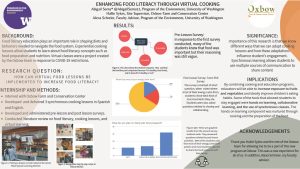Enhancing Food Literacy Through Virtual Cooking
Food literacy is composed of a collection of skills and behavior needed to navigate the food system. Current hands-on learning methods related to food literacy include school gardens, field trips, and outdoor farm work. Cooking lessons allow students to use experiential learning to go hand in hand with classroom topics. The synchronous lessons were developed as a response to COVID regulations. The purpose of this study was to identify how cooking lessons can be implemented in the digital classroom in relation to students in grades 4 and 5. To accomplish this task I delivered a series of cooking lessons and utilized questionnaires and observations to evaluate the student’s response to engagement measures and lesson content. These surveys were administered online and in-person. During my time assisting the educators and farmers at Oxbow Farm and Conservation Center, we delivered synchronous cooking lessons to 4th and 5th grade students from Frank Wagner Elementary. With the collection of survey results and conference content, I found that the experiential learning component helped students engage with educators during the cooking lesson. Collaborative learning is essential to communicate with the students as well as teachers, especially if students are given multiple platforms to communicate with others. Lastly, synchronous learning is a tool that can be used to provide support to students while they are completing activities related to food literacy education as well as other educational concepts.
